[ad_1]
Over 5 million people live in Alabama. Many of these people have experienced natural disasters in the state firsthand or had to evacuate because of disasters. However, many Alabamans don’t realize just how many types of natural disasters can occur in the state.
This analysis goes over what natural disasters occur in Alabama, the worst natural disasters to hit the state since 2000, and what residents can do to prepare.
Is Alabama At Risk of Natural Disasters?
Compared to the rest of the United States, Alabama has a medium risk of natural disasters. Alabama has had 47 disaster declarations since 2000. Of these, 38 were declared major disasters.
Alabama is also frequently hit by natural disasters, which cause more than $1 billion in damages. Since 2000, there have been more than 73 separate $1-billion events.
Note that these events – such as Hurricanes Nicolas and Ida – affected nearby states as well. The events did not cause $1 billion in damages in Alabama alone and weren’t always devastating enough to merit a disaster declaration.
Natural disasters occur during all times of the year in Alabama but are most common from March to October.
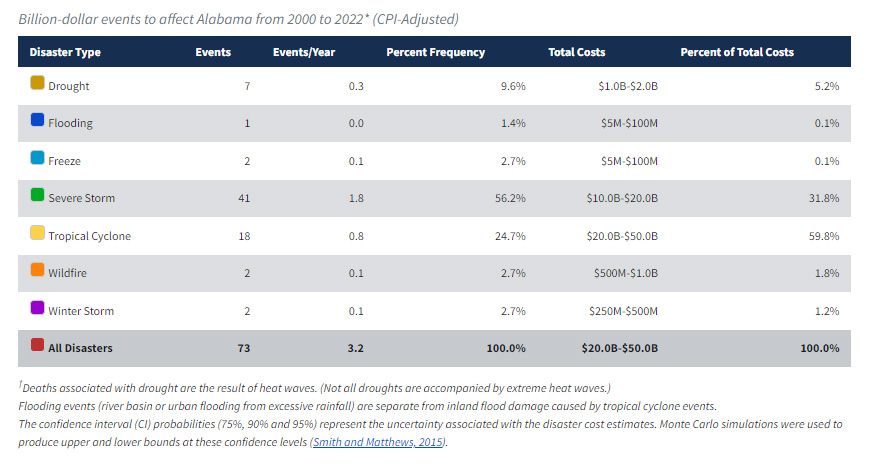
Worst Natural Disasters in Alabama
Since 2000, all of the worst natural disasters in Alabama have been hurricanes. The costliest ones were hurricanes Katrina, Harvey, Ida, Irma, and Ike. In addition to hurricanes, tornadoes and heat waves have been particularly devastating in Alabama and caused many deaths.
Worst Natural Disasters in Alabama By Cost (Since 2000)
- Hurricane Katrina 2005: $186.3 billion
- Hurricane Harvey 2017: $148.8 billion
- Hurricane Ida 2021: $78.7 billion
- Hurricane Irma 2017: $59.5 billion
- Hurricane Ike 2008: $40.2 billion
Worst Natural Disasters in Alabama By Deaths (Since 2000)
- Hurricane Katrina 2005: 1,833 deaths
- Southeast/Ohio Valley/Midwest Tornadoes 2011: 321 deaths
- 2000 Western Central/SE Drought and Heat Wave 2000: 140 deaths
- 2012 Drought and Heat Wave: 123 deaths
- Hurricane Rita 2005: 119 deaths
*Cost and death tolls are for the entire disaster, including in other states affected.
Most Common Natural Disasters in Alabama
1. Severe Storms
Alabama is regularly hit by severe storms, including tornadoes. Since 1950, there have been over 600 tornadoes in Alabama with a magnitude of 2 (F2) or above. Several of these were rated F5 or above. Because the risk is so high, residents should have an underground tornado storm shelter.
Since 2000, the state has declared disaster 26 times because of severe storms. Of all the $1 billion events to hit Alabama during that period, more than half were severe storms. These collectively caused $10-$20 billion in damages.
In addition to tornado storms, Alabama also regularly has severe thunderstorms. The high winds and lightning can damage roofs and siding. Falling tree branches also pose a risk. In 2021 alone, there were 27 days in Alabama with a severe storm event.
Severe storms occur in all parts of Alabama but are most likely in the northern parts of the state. They occur most frequently in March and April.
Worst Tornadoes in Recent Alabama History
- April 2011 Tornadoes: $13.3 billion in damages and 321 deaths
- May 2003 Tornadoes: $6.6 billion in damages and 51 deaths
- March 2012 Tornadoes: $4 billion in damages and 42 deaths
- April 2020 Tornadoes: $3.9 billion in damages and 35 deaths
- March 2017 Severe Weather: $3.2 billion in damages and no deaths
2. Hurricanes
Alabama is one of the most at-risk states for hurricanes. Since 2000, there have been 18 billion-dollar hurricanes that have affected Alabama. Collectively, these hurricanes caused $20 to $50 billion in damages.
The coastal area in the south of the state is most at-risk of hurricanes. Still, even people living in the inland parts of Alabama can have their homes destroyed, face power outages, and other damage from hurricanes. Because of climate change, hurricanes in Alabama are only likely to get stronger and occur more frequently.
Recent Hurricanes in Alabama ($1 billion events):
- Hurricane Nicholas Sept 2021
- Hurricane Ida August 2021
- Tropical Storm Fred August 2021
- Hurricane Zeta October 2020
- Hurricane Delta October 2020
Worst Hurricanes in Alabama History
- Hurricane Katrina 2005: $186.3 billion in damages and 1,833 deaths
- Hurricane Harvey 2017: $148.8 billion in damages and 89 deaths
- Hurricane Ida 2021: $78.7 billion in damages and 96 deaths
- Hurricane Irma 2017: $59.5 billion in damages and 97 deaths
- Hurricane Ike 2008: $40.2 billion in damages and 112 deaths
For more, read: How to Prepare for a Hurricane
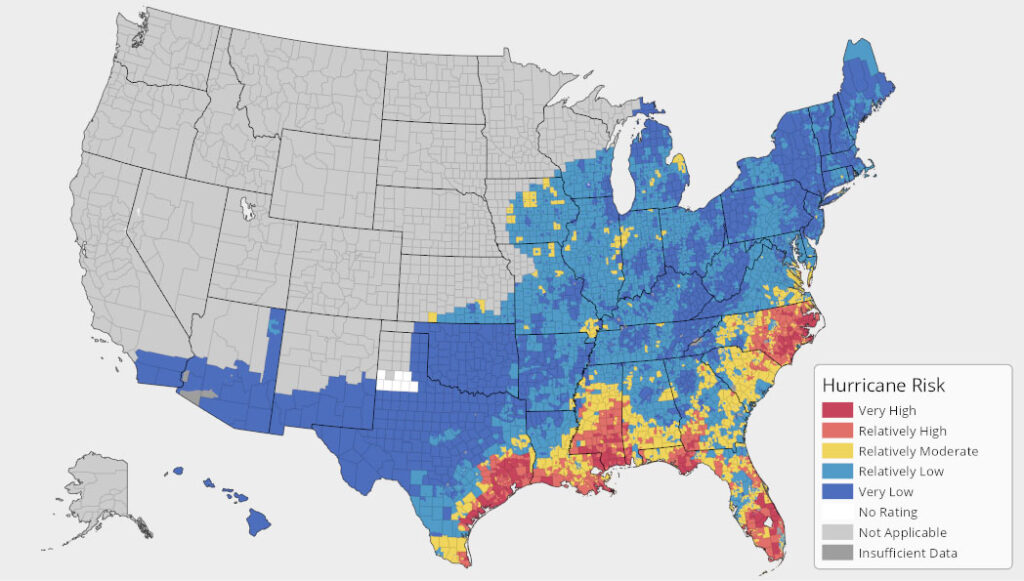
3. Flooding
Alabama has only had one $1 billion flood event since 2000. However, that doesn’t mean Alabama isn’t at risk of flooding. Floods frequently occur in Alabama due to hurricanes, heavy rainfall, and river overflowing. Flash floods can also occur.
The 2020 First National Flood Risk Assessment estimated that over 330,000 properties in Alabama are at risk of flooding. This includes 29% of properties in Mobile and 17% in Birmingham. Because of climate change, the risk of flooding will only get higher in Alabama.
Recent Major Floods in Alabama:
- March 2022: Parts of Birmingham were flooded after heavy rainfalls, causing multiple people to get trapped in their vehicles.
- October 2021: Four people died after heavy rains caused rapid flooding. The deaths occurred when the flood water swept away vehicles. Fire officials had to perform 82 rescues from flooded homes and another 20 rescues from cars.
- Sept 2021: Heavy rains caused roadways in Tuscaloosa to flood. One person died, and many had to be rescued from their vehicles.
Also read: How to Prepare for Flood Disasters
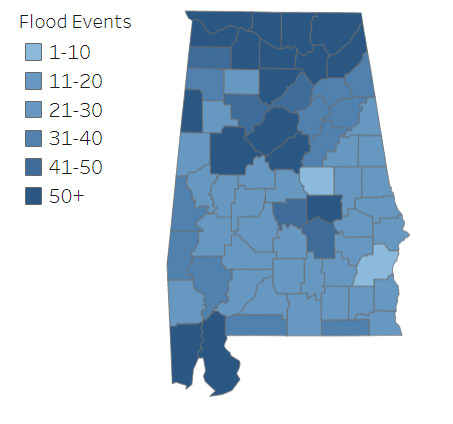
4. Heat Waves and Drought
Alabama is the 4th wettest state in America and droughts are generally uncommon. However, drought risk is increasing, with many parts of the state listed as “abnormally dry.” An estimated 1.3 million people in Alabama live in drought areas.
Heat waves often come with drought. Heat-wave fatalities aren’t common, but injuries do occur. For example, during the 2007 heat wave in Alabama, nearly 700 people were treated for heat stress. Drought also hugely impacts Alabama’s agriculture, causing crop failures and lower yields.
Also read: How to Prepare for Heat Waves
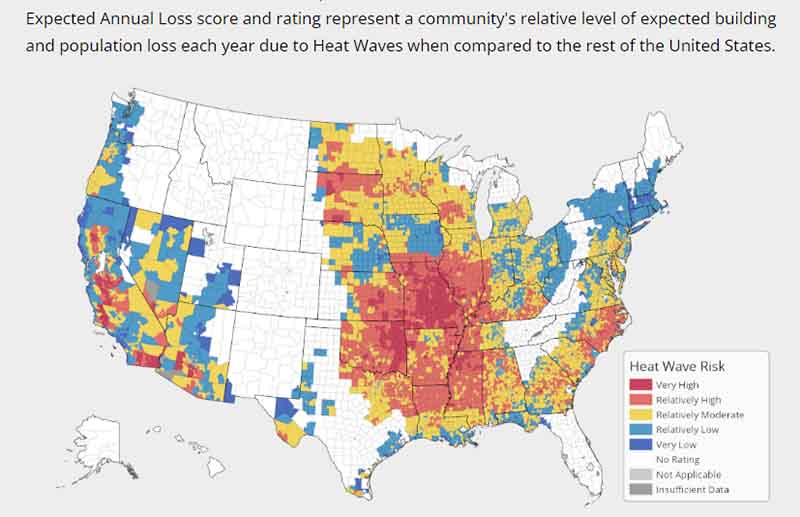
5. Wildfires
Because it has a wet climate, Alabama is not at high risk for wildfires. Further, Alabama State has taken fire-prevention methods, such as thinning trees susceptible to fire. But wildfires are still a concern in Alabama.
The state averages 1,300 wildfires per year, but the number is higher during times of drought. In 2021, when 1/3 of Alabama was experiencing abnormally dry conditions, there were over 1,600 wildfires that consumed over 35,000 acres. The smoke from wildfires in Alabama can cause breathing problems and increase the risk of lung cancer, stroke, and other illnesses.
The risk of wildfires in Alabama is only increasing, so residents should take steps to prepare. This includes being ready to evacuate quickly, keeping vital documents safe from fire, and having respirator masks to protect their lungs from smoke inhalation.
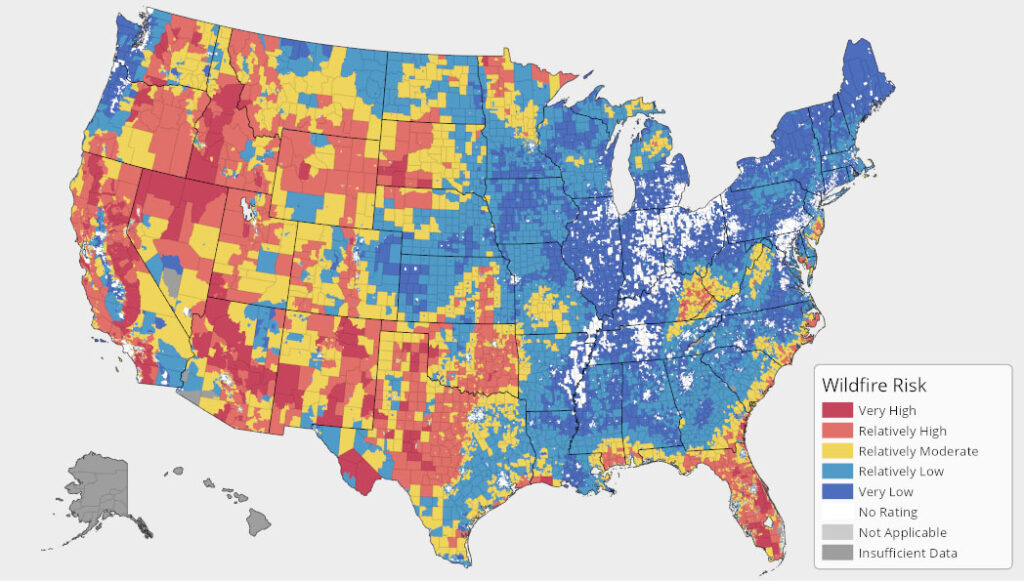
6. Snow Storms and Freezing
While Alabama isn’t at high risk of severe winter weather, it doesn’t mean that events don’t occur. Since 2000, there have been 4 winter storm and freeze events in Alabama which caused more than $1 billion in damage.
Because cold weather events don’t frequently occur in Alabama, they can catch residents unprepared. Power outages often occur during these winter storms, and few people in Alabama have backup generators or an emergency heater. The road conditions also can become difficult for driving, and vehicle accidents occur.
[ad_2]
Source link
